Our private label product is one step closer to launching on Amazon’s FBA program, and the excitement is burning (excuse the poor pun on marshmallow roasting sticks). In our product launch case study, we have previously gathered private label product ideas, chose the product based on actual Amazon sales data, found manufacturers and suppliers on Alibaba, and negotiated our order. With the product ordered and set to arrive on our doorstep in early December, we are at the stage of preparing our Amazon listing so that once the product hits our doorstep and passes our quality inspection, we will take our product photos, and send in the shipments to Amazon warehouses. From there, it will be a simple click of the mouse to publish our fully-prepared listing. Just in time for holiday campfires!
If you want to join our next webinar series, please head over to this page to register for free so that we can have you join us live at the next webinar and answer your specific questions.
This week was a special occasion, as we had The Amazing Seller himself, Scott Voelker, join us! You most likely already know Scott from his great podcast and blog, where he hosts successful and insightful guests to dig deep into the details of creating, scaling, and replicating successful businesses on Amazon. Scott is incredibly generous and transparent with sharing knowledge about everything related to Amazon, so I knew this would be a great session.
You can watch Greg and Scott dissect the elements of a successful pre-launch program and create an ideal product listing here:
[x_video_embed type=”16:9″][/x_video_embed]
LOGO AND DESIGN WORK:
Last we spoke, we were working on getting our label and branding prepared (you can see the description and request we sent to our designer here). And here’s what the final label will look like, what do you think? Thanks to the wit of the chat room at the webinar for the “Jungle Stix” name!
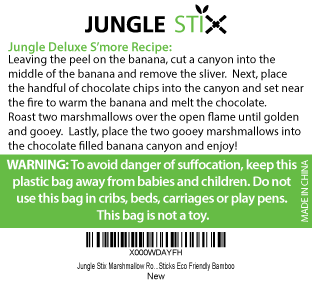
You’ll see that the suffocation warning is included as well, it was not necessarily a requirement (since our largest opening is likely smaller than 5 inches) , but included just to be safe. Erring on the side of caution is a modus operandi at Jungle Stix! The FNSKU was included on the label as well, which saves the $0.20 per unit instead of having Amazon apply it to each product. We are also all about cost efficiencies and finding profit in the pennies.
While we did use our privileged position of having a graphic designer on our team, one could easily outline the design requirements as we did, and go to Upwork or Fiverr to get a logo designed and a label created. Alternatively, you may have Photoshop skills which could do the trick, or Scott recommends Canva. The design work is completed for the moment, and of course can always be tweaked in the future if we were to order another shipment.
CREATING AN OPTIMIZED AMAZON LISTING:
The first step we took to create an optimized listing was identifying the main keywords that we would want our Jungle Stix to rank for on any given Amazon search. As Amazon is one of the top search engines in the world (third biggest in terms of search volume, after Google and YouTube), creating our listing on the front end (for the potential customer) and backend (for Amazon’s algorithms) is of utmost importance. A helpful initial step is evaluating the keywords that competitive products use in the Title and Product Description.
Looking at the competitive products, the main keywords appear to be:
- marshmallow sticks
- roasting sticks
- s’mores sticks
- environmentally friendly
These are just a few of the keywords that we’ll use to start the listing, but the true keyword gold will come to us once we start our pay per click campaigns and we get actual customer search queries and see what search queries convert.
Scott shared a nifty Pro Tip in terms of creating a listing and positioning a product for Amazon SEO success before actual launch. Here it is: when creating the first draft of your listing, put the main keywords (also known as “head terms” in your Product Title, prioritized by importance. Leave the product description blank, save and exit the listing. At this point, you have enough of a listing for Amazon to potentially start indexing it in their product catalog, and could position your product rank for the head terms you included in the Title, as well as have those terms included in the URL.
Here’s a screenshot of how that would look in reality:
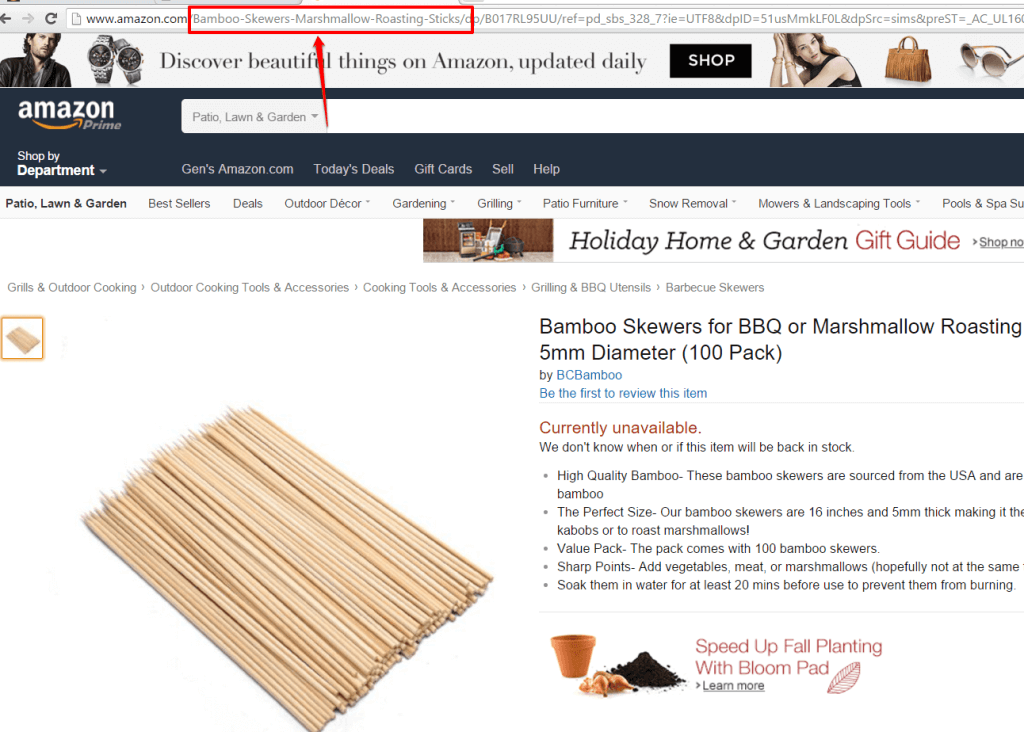
At this point though, only an Individual Seller Account (which is free) is needed. Once you start selling though, it is worthwhile to upgrade to the Professional Sellers account (assuming that you will be selling more than 40 per month).
We entered “Marshmallow sticks” to find some of the Categories that Amazon suggests. The Categories are not super important, mainly because Amazon is such a keyword and search query focused platform. However, it also helps to take a peak at the competition to see the Categories that they are having success with. And therein lies a key tenet for Amazon success: identify what is working well for other sellers, and optimize and improve where there is opportunity.
For the title then, we wanted to incorporate as many keywords as we could, in order of priority and relevancy. Marshmallow roasting stick bamboo skewer 36” 110 per unit campfire camping hotdogs corn.
You’ll notice that we did not include “Jungle Stix” in the Title at the moment because no one knows the brand, and no one will be searching for it. However, you never know what product Jungle Creations may release next to internet viral fame, you will have to stay tuned….
A lot of the fields aren’t necessary to complete in. It doesn’t necessarily hurt to include the information, but if it is not necessary and we do include some information that limits the search volume we can compete for, then of course it is best to not include information that you don’t need to.
Another Pro Tip from Scott at this stage of creating the product listing: set up your listing to have the potential to be a variation in the future, ie as a “variation theme”. This means that down the road, depending on how the product sells, we could include a metal variation for example, or bundle these together into a 3-pack or some other variation. It is best to create the optionality for future variations, instead of ignoring the Variation Theme now and having to deal with Seller Central in the future (which may be a large investment of time and energy, or even a loss of reviews).
PHOTOS:
You don’t need to include any photos at this point, you can just upload your label but without product at Amazon’s warehouses, this is a moot point at the moment. We are looking for high quality product photographers at the moment though, and ready to invest in the best, as it will pay dividends in the future with an increased conversion rate and improved ranking.
CREATING THE PRODUCT FEATURES AND PRODUCT LISTINGS:
Here is where you want to create the text for the five bullet points. Scott recommends using capital letters to help the main keywords visually stand out to the potential customer. This creates a visual cue to the customer that these are the most important takeaways from the product description, while also having some search benefits. He notes that you would also want to focus on what the benefits are with these initial “power words”, which we have done like so:

How many characters are you allowed to include? Amazon states that it is 100 characters, though by looking at some competitive examples, this limit can vary based on Amazon’s whims, er, testing. Regardless of what our limit is, it is most important to include as many characters as possible in these bullets, as we want these to appeal to the customers as well as Amazon algorithms. The images, Title, and price will hold a greater influence on our sales, as will reviews, but we definitely want to make these product descriptions as robust as possible so that we can get the most keyword exposure once our PPC campaigns are on as well.
KEYWORD RESEARCH:
In addition to peeking at competitive listings, Google Keyword Planner will offer some good suggestions, as well as a proxy (based on Google searches per month) for how much volume a given search query will get. The Google Keyword Planner is completely free (you do have to create an AdWords account though, you can do so here, but you do not ever have to run any campaigns or incur a cost].
Here are some of the suggestions that we see related to “marshmallow sticks”:
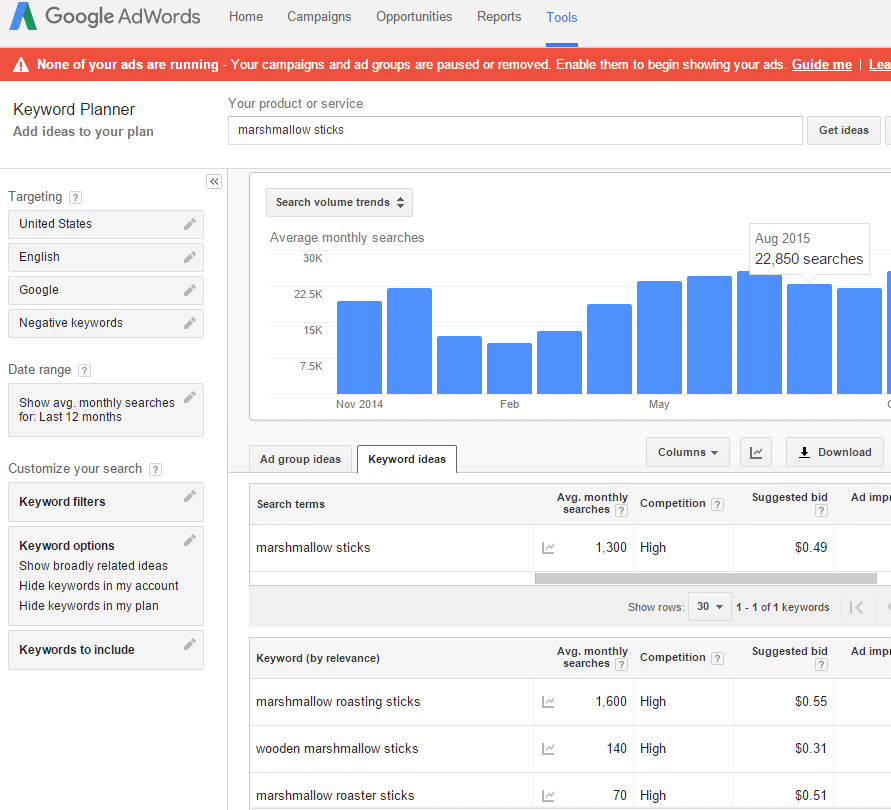
Scott offered another helpful hack here, where you can easily identify any keywords that you may not have found initially: simply drop a competitors Amazon URL into the Keyword Planner:
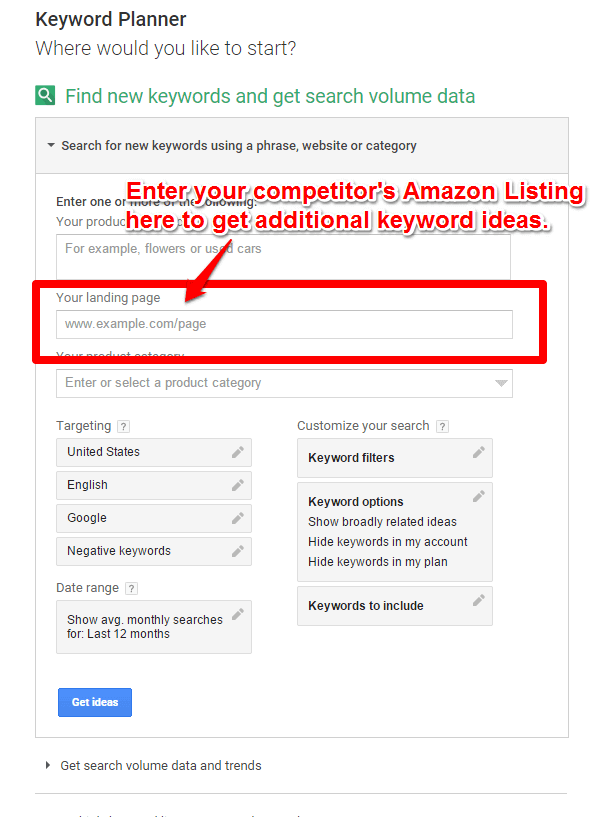
And see the results that come up:
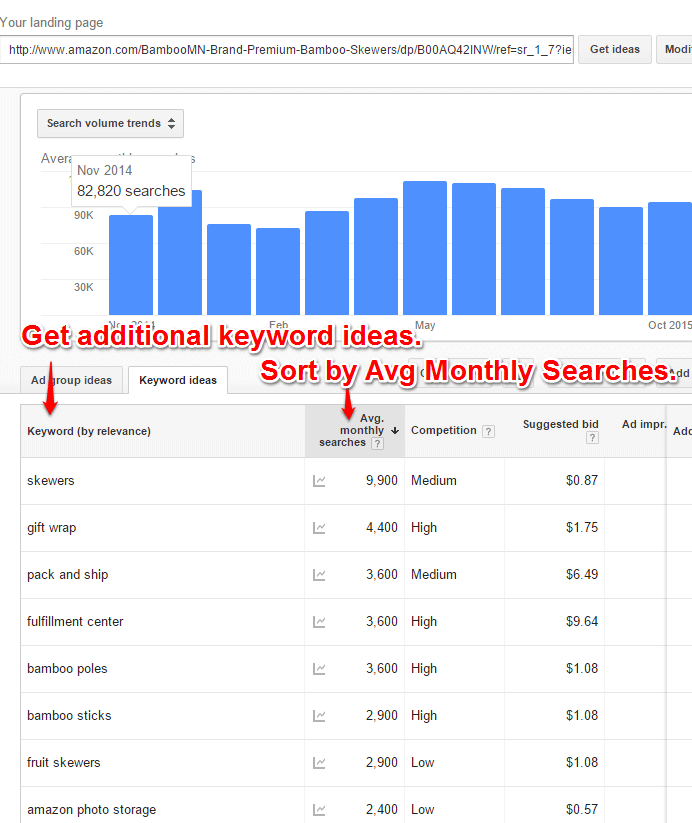
ADDING BACKEND KEYWORDS TO IMPROVE AMAZON SEO:
Part of your product listing will not be visible to the public, but is intended to add more information to help Amazon know what keywords and audiences are relevant for your product. If there’s one Pro Tip from Scott that you’ll want to know, it is this: DO NOT INCLUDE COMMAS IN YOUR BACKEND KEYWORDS. Amazon interprets commas (and punctuation in general) as an indication to refine and narrow the keywords that your product could match for. His recent experience with commas in this keyword section resulted in Amazon only suggesting a couple keyword ideas in the Autocampaign and Suggested Bids campaign. However, when the commas were removed, Amazon all of a sudden included more than a hundred suggested keywords. All just by removing the commas. So don’t include commas in the keyword section!
Again, as this is not visible to the public, it would be in your best interest to include your competitors in this section if there is a major brand in the niche. There may not be for our Marshmallow roasting sticks, but it doesn’t hurt to include a few successful sellers, which we have done:

There are many additional sections that are additional fields but not necessarily relevant to our product (for example, product material, moisture instructions, etc). Not all of these are needed.
A few that are important though:
- “Package Dimensions”: is used by Amazon for calculating the FBA fees. Therefore, it is best to wait until you have the actual product in hand and can enter the accurate measurements in this field.
- Pricing: The “Suggested Retail Price” is going to be the highest price, and one which you can include a strikethrough if you add the discounted price. To really nail home the discount in the customer’s psyche, you can also have the “Sale” price to show an additional markdown. It is common practice to at least have a discount on the Suggested Retail Price, even if it is common knowledge that it is all part of the Amazon dog-and-pony show.
So that about leaves us with an optimized first draft of our Amazon listing! It is important to note though that much of this (outside of the UPC code) can be altered down the road, and in fact should be optimized on an ongoing basis based on what sales data and customer search query data we generate once the product listing is live and our PPC campaigns are running.
There were a few questions regarding sales tax and best practice. As it is so dependent on a case-by-case basis, Scott recommends the resources at TaxJar for further information.
And when will we meet again for our webinar? Well, that depends, of course! In our next webinar, we will cover how we create the fulfillment order, and the process and strategies we took with our product photos. Plan for sometime in early December after Turkey Day. In the meantime though, please drop any comments or thoughts in the comments below, join our Facebook Group at the FBA Competitive Edge, or learn tons more from Scott, whether on his podcast, blog, or Facebook group. He is a tremendous resource and has much to offer, so definitely take advantage of that.
Until next time REGISTER HERE SO THAT WE CAN LET YOU KNOW WHEN THAT IS….

 15 Comments
15 Comments
15 comments on “Our Collaborative Private Label Launch Session #5: Pre-Launch Tactics, with Scott Voelker”